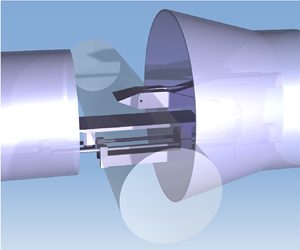Article contents
Pressure plateau of separation induced by shock impingement in a Mach 5 flow
Published online by Cambridge University Press: 26 September 2023
Abstract

Separation induced by impinging shock is a fundamental feature in supersonic and hypersonic flows; however, it is difficult to predict the pressure plateau due to a limited theoretical understanding of the effect of impinging shock strength. In this study, the evolution of the separation configuration and pressure distribution with changes in impinging shock angle is examined, and a theoretical equation for predicting the pressure plateau based on minimum entropy production is proposed. For validation, an experimental device that can measure wall pressure in the separation region at high spatiotemporal resolution is developed, and schlieren visualization is employed to capture the flow structure. Accordingly, the fine characteristics of pressure distributions along the centreline of the separation region as well as the reattachment region induced by shock impingement at various angles ( $8.5^\circ$ to
$8.5^\circ$ to  $30.5^\circ$) are obtained in a flow of Mach number 5 and Reynolds number
$30.5^\circ$) are obtained in a flow of Mach number 5 and Reynolds number  ${\approx }1.4\times 10^7\ {\rm m}^{-1}$. The experimental results agree well with the theoretical results; both indicate that the pressure distribution is strongly related to the impinging shock strength and that there is a critical flow deflection angle
${\approx }1.4\times 10^7\ {\rm m}^{-1}$. The experimental results agree well with the theoretical results; both indicate that the pressure distribution is strongly related to the impinging shock strength and that there is a critical flow deflection angle  $\alpha ^\ast$ (
$\alpha ^\ast$ ( ${\approx }20.8^\circ$ for Mach 5). The pressure in the separation region grows nearly linearly with increasing impinging shock strength when the flow deflection angle of the impinging shock is less than
${\approx }20.8^\circ$ for Mach 5). The pressure in the separation region grows nearly linearly with increasing impinging shock strength when the flow deflection angle of the impinging shock is less than  $\alpha ^\ast$; the pressure stops growing and resides in a small range when the flow deflection angle is larger than
$\alpha ^\ast$; the pressure stops growing and resides in a small range when the flow deflection angle is larger than  $\alpha ^\ast$. Therefore, the impinging shock strength should be considered a main factor when predicting the pressure plateau.
$\alpha ^\ast$. Therefore, the impinging shock strength should be considered a main factor when predicting the pressure plateau.
- Type
- JFM Rapids
- Information
- Copyright
- © The Author(s), 2023. Published by Cambridge University Press
References
- 2
- Cited by



